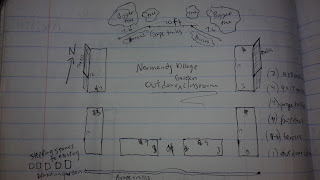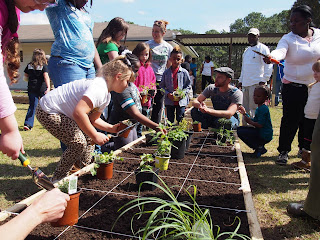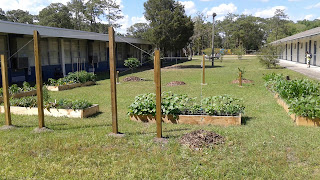before you can help kids get their hands dirty like this,
or teach kids in your school garden like this,
there are a few things you've got to take care of first.
The #1 most important thing you've got to do is build your team. I say- with no exaggeration-- that human infrastructure is THE most important aspect of developing a successful school garden. But, I already wrote about building your school garden team last time. Assuming you're on track with that, a simultaneous step is to begin developing your school garden design.
Here are a few things to should consider as you develop a school garden design:
Purpose
- In your school garden interest meeting, one of the first questions you should ask is: "Why are you interested in a school garden?" Interestingly, this question serves two purposes. First, it helps the team gel because there will likely be a lot of overlap in answers. This will lend itself to a sense of shared purpose. Secondly, use these answers to guide your design-- with regard to size & features as well as programmatic elements. For example, if teachers want to hold class in the garden, there should be an "outdoor classroom" aspect. Another way of saying this is that the best physical designs help programmatic design dreams come to fruition.
- Where do kids run and play? Don't get in the way.
- Where are the existing footpaths worn-down through the grass? That might be where your pathways should be-- but definitely not where your beds or fruit trees should go.
- Is there a bench outside for student/administrator 1-on-1 conversations? Could it be incorporated into the garden?
- Sunlight I. In order to grow, plants need sunlight. Food crops require 4-5 hours of direct sunlight as a bare minimum.
- Sunlight II. Here in the northern hemisphere, the sun dips towards the south (moreso in winter, less in summer), so tall objects will cast shadows (to the north)-- especially in the winter. Think about this when locating your garden next to buildings, near trees, and when thinking about where to plant fruit trees or tall crops (like sunflowers).
- Sunlight III. In Florida, given our extreme heat, if you have to choose, it's better to have morning sun and afternoon shade than the opposite.
- Water. Is there a water faucet within 25-50ft of your food garden? If not, is there a way to get one installed? Are you going to run a micro-irrigation system? Be sure to leave a clear path if you need to run pipe underground for a new faucet.
- Visibility. The more visible a food garden, the more successful it will be. Think "front yard," not "back yard." My personal raised bed food gardens are immediately next to my front sidewalk; therefore, I walk by my garden daily. When there are weeds, I pull them; it takes 10 seconds. When there is produce ready to pick, I see it. Whenever a garden is out of sight, it is out of mind; whenever one has to "go garden," they don't. Grow your school garden as close as possible to where you and the school community pass by every day.
- Paths, gates, etc. should be wide enough for a wheelbarrow to fit. If the paths will remain grass, be sure they are wide enough for your mower to fit. If you don't know how the grass is cut, ask facilities. (While you're at it, ask facilities if there is anything else you should know; any input they have. Their knowledge of school infrastructure, past events, how things get done, and the like is invaluable.)
- Make sure the distinction between paths and beds is clear; this makes it easy for students & visitors to walk through the garden without worry and without killing things. You can do this, for example, by building raised beds or by clearly mulching pathways with wood chips.
- If you're building a garden for middle or high schoolers, the maximum width of beds should be 4 feet. For preschool and elementary school gardens, the max should be 3 feet. Why? Because that's the maximum distance that hands can reach from the sides of the beds without having to step into the garden beds, thereby saving your soil from compaction. (Length does not matter.)
- Start small. Any small, successful school garden can get bigger. On the other hand, school gardens that start off too big very rarely shrink; they fail.
- Enclosure. If there is a way to do so, design the garden so you can go "into" it. Think gates, arbors, or fruit trees, grape vines outlining the space, or simply beds to outline entrances and the perimeter. Somehow, create a sense of enclosure so that when children are "in" the garden, they know it and feel it.
- Google SketchUp is a free design software. Watch a few SketchUp YouTube tutorials like I did, and you'll be able to create basic to-scale food garden designs within an hour or two.
Seminole Montessori Preschool Garden Design (Tallahassee)
- (4) 3'x3' raised beds with 3' pathways between all four beds in all directions
- (2) trellises that inter-connect beds with arbor-isk arches. These serve as a structure for climbing crops like sugar snaps. They also provide a fun pass-through to give preschoolers the opportunity to "run through" the garden, especially once the crops cover the wire arches.
- Garden is located in the playground field near-- but not in the way of-- other playground equipment and heavy traffic pathways.
- When I was still in Tallahassee, I returned each season to work with the kids to top-dress the beds with fresh compost and to replant seasonal veggies. Week-in, week-out, the teachers helped preschoolers water, and they harvested veggies and incorporated them into their school snacks.
We started our design effort at Normandy Village in the initial interest meeting comprising a couple teachers, the guidance councilor, principal, and a few students from their Leadership League. First, I asked "Why are you interested in a school garden?" Next I asked, "What do you imagine in or about the Normandy Village Elementary School Garden? What does your dream school garden look like? What ideas do you have?" I gave everyone a piece of paper, and asked them to take a few minutes to write or draw their answers. Then we shared with one another. Here are two examples:
As you can see from these two examples, there are both physical design ideas (fruit trees, garden boxes, "lots of color") as well as program design ideas (parent involvement, vegetables of the month).
Before our next school garden team meeting, I took the many ideas generated by the school garden team and played with them in the context of the space the principal had selected. I took into account things like sunlight, water, existing features, where people walk, how to create a sense of enclosure, appropriate bed width, and the many other things above. Additionally, my wife, Mary Elizabeth, who teaches 8th grade, had-- the week before-- asked me to help her rearrange the desks in her classroom. As part of this, I measured her classroom length and width. It was 27x28 feet. As I was preparing the Normandy Village design, I thought, "Could I incorporate a classroom-sized open-space in which teachers could gather their classes in the midst of the garden?
Here is my rough draft sketch:
 |
| Notebook rough draft |
I sent this picture to the principal. She & other members of the school garden team approved, so I committed it to Google SketchUp:
 |
| Design to-scale via Google Sketchup |
And here it is the "Normandy Village Outdoor Garden Classroom" two months later, just waiting on the grape vines to grow up the trellis and the fruit trees to fill out the space behind where a teacher would stand at at the front.
- - -
If you think a bit of support to launch -- or sustain-- your school garden would be helpful, give me a buzz. As I'm able (and you're in NE FL), I'm happy to participate in your school garden interest meeting or assess your space and offer my thoughts on your design. Should you want more committed assistance, reach out. It's what I do.
One parting piece of advice: if you're filling raised beds, make sure you start with the best compost-based mix available. If you're in the Jacksonville area, I sell my Magic Mix in bulk at a steep discount to school and community gardens. If you're in Tallahassee, Compost Community is your go-to. If you are somewhere else, make sure that several long-time area gardeners vouch for the mix you'll be using. You'll thank yourself when the kids "Oooo" and "Ahhh."
- - -
If I can support you...
in growing food for self and neighbor, please, let me know how I can help or go ahead and book me for a site visit. I offer turn-key food gardening support services here in NE FL and can support aspiring food gardeners in other places across the Deep South as well. To inquire about that, email me.
If you'd like to support me...
in sharing my stories & expertise, please consider offering a donation to my tip jar and passing along this update to a friend. Each of my updates take 5-10 hours of resource gathering, writing, and editing, so I want to make sure they don't just sit on the digital shelf.
Respectfully,
Nathan Ballentine (Man in Overalls)
Itinerant Urban Farmer, Entrepreneur, Educator, Community Organizer
Growing in Jacksonville, FL. Connecting Globally.
(904) 240-9592
Email Man In Overalls
Man in Overalls on FB & IG
ManInOveralls.com
Blog - Services - Projects - Resources - About
---
If you would like to receive my "semi-monthly" updates, which include a story and food gardening tip, please click here.
Respectfully,
Nathan Ballentine (Man in Overalls)
Itinerant Urban Farmer, Entrepreneur, Educator, Community Organizer
Growing in Jacksonville, FL. Connecting Globally.
(904) 240-9592
Email Man In Overalls
Man in Overalls on FB & IG
ManInOveralls.com
Blog - Services - Projects - Resources - About
---
If you would like to receive my "semi-monthly" updates, which include a story and food gardening tip, please click here.





